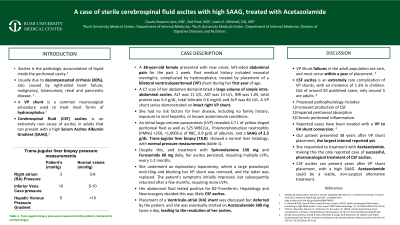Tuesday Poster Session
Category: Liver
P3900 - A Case of Sterile Cerebrospinal Fluid Ascites Decades After Ventriculoperitoneal Shunt Placement Successfully Treated With Acetazolamide Monotherapy
Tuesday, October 24, 2023
10:30 AM - 4:00 PM PT
Location: Exhibit Hall

Has Audio

Dauris Rosario Lora, MD
Rush University Medical Center
CHICAGO, IL
Presenting Author(s)
Dauris Rosario Lora, MD, Zoë Post, MD, Justin Mitchell, DO
Rush University Medical Center, Chicago, IL
Introduction: Ascites is defined as a pathologic accumulation of liquid inside of the peritoneal cavity. Although usually a consequence of decompensated cirrhosis (80%), it can also be caused by right-sided heart failure, malignancy, tuberculosis, renal and pancreatic disease. Cerebrospinal fluid (CSF) ascites is an extremely rare cause of ascites in adults that can present with a high serum albumin ascites gradient (SAAG). Here we present a case of a patient with confirmed CSF ascites, who developed symptoms almost 40 years after the placement of her VP shunt and was treated successfully with Acetazolamide.
Case Description/Methods: A 38-year-old female presented to the emergency department for new onset, left-sided abdominal pain for the past 1 week. Her past medical history included neonatal meningitis, complicated by hydrocephalus, treated by placement of a bilateral ventriculoperitoneal (VP) shunt during her first year of age. No risk factors for liver disease were identified. A CT scan of her abdomen demonstrated a large volume of simple intra-abdominal ascites. ALT was 11 U/L, AST was 14 U/L, INR was 1.05, total protein was 6.4 g/dL, total bilirubin 0.6 mg/dL and ALP was 46 U/L. A VP shunt series demonstrated an intact right VP. An initial large volume paracentesis (LVP) revealed 4.7 L of yellow tinged peritoneal fluid with SAAG of 2.3. Trans-jugular liver biopsy showed a normal liver, with normal pressure measurements. Her ascites persisted, requiring multiple LVPs intermittently. She underwent an exploratory laparotomy, where a large pseudocyst encircling her VP shunt was removed, and the latter was replaced. The patient’s symptoms initially improved, but subsequently returned. Her abdominal fluid tested positive for B2-Transferrin, which is diagnostic for CSF ascites, and she was eventually started on Acetazolamide 500 mg twice a day, leading to resolution of her ascites.
Discussion: CSF ascites is a rare complication of VP shunts, with an incidence of about 1.3% in children. Of 50 cases reported in literature, only around 5 are in adults. Proposed pathophysiology includes decreased peritoneal absorption of fluid, overproduction of CSF, and chronic peritoneal inflammation. Usual treatment is conversion of VP shunt to a ventriculo-atrial shunt. Our unique case highlights the importance of considering CSF ascites as part of the differential in patients with ascites of unknown etiology, as well as a consideration of non-invasive therapies including acetazolamide
Disclosures:
Dauris Rosario Lora, MD, Zoë Post, MD, Justin Mitchell, DO. P3900 - A Case of Sterile Cerebrospinal Fluid Ascites Decades After Ventriculoperitoneal Shunt Placement Successfully Treated With Acetazolamide Monotherapy, ACG 2023 Annual Scientific Meeting Abstracts. Vancouver, BC, Canada: American College of Gastroenterology.
Rush University Medical Center, Chicago, IL
Introduction: Ascites is defined as a pathologic accumulation of liquid inside of the peritoneal cavity. Although usually a consequence of decompensated cirrhosis (80%), it can also be caused by right-sided heart failure, malignancy, tuberculosis, renal and pancreatic disease. Cerebrospinal fluid (CSF) ascites is an extremely rare cause of ascites in adults that can present with a high serum albumin ascites gradient (SAAG). Here we present a case of a patient with confirmed CSF ascites, who developed symptoms almost 40 years after the placement of her VP shunt and was treated successfully with Acetazolamide.
Case Description/Methods: A 38-year-old female presented to the emergency department for new onset, left-sided abdominal pain for the past 1 week. Her past medical history included neonatal meningitis, complicated by hydrocephalus, treated by placement of a bilateral ventriculoperitoneal (VP) shunt during her first year of age. No risk factors for liver disease were identified. A CT scan of her abdomen demonstrated a large volume of simple intra-abdominal ascites. ALT was 11 U/L, AST was 14 U/L, INR was 1.05, total protein was 6.4 g/dL, total bilirubin 0.6 mg/dL and ALP was 46 U/L. A VP shunt series demonstrated an intact right VP. An initial large volume paracentesis (LVP) revealed 4.7 L of yellow tinged peritoneal fluid with SAAG of 2.3. Trans-jugular liver biopsy showed a normal liver, with normal pressure measurements. Her ascites persisted, requiring multiple LVPs intermittently. She underwent an exploratory laparotomy, where a large pseudocyst encircling her VP shunt was removed, and the latter was replaced. The patient’s symptoms initially improved, but subsequently returned. Her abdominal fluid tested positive for B2-Transferrin, which is diagnostic for CSF ascites, and she was eventually started on Acetazolamide 500 mg twice a day, leading to resolution of her ascites.
Discussion: CSF ascites is a rare complication of VP shunts, with an incidence of about 1.3% in children. Of 50 cases reported in literature, only around 5 are in adults. Proposed pathophysiology includes decreased peritoneal absorption of fluid, overproduction of CSF, and chronic peritoneal inflammation. Usual treatment is conversion of VP shunt to a ventriculo-atrial shunt. Our unique case highlights the importance of considering CSF ascites as part of the differential in patients with ascites of unknown etiology, as well as a consideration of non-invasive therapies including acetazolamide
Disclosures:
Dauris Rosario Lora indicated no relevant financial relationships.
Zoë Post indicated no relevant financial relationships.
Justin Mitchell indicated no relevant financial relationships.
Dauris Rosario Lora, MD, Zoë Post, MD, Justin Mitchell, DO. P3900 - A Case of Sterile Cerebrospinal Fluid Ascites Decades After Ventriculoperitoneal Shunt Placement Successfully Treated With Acetazolamide Monotherapy, ACG 2023 Annual Scientific Meeting Abstracts. Vancouver, BC, Canada: American College of Gastroenterology.
